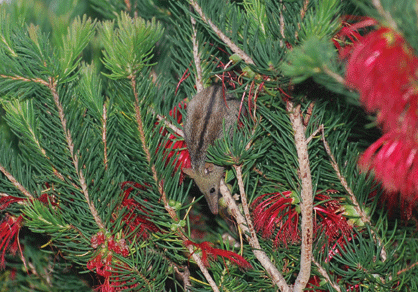
|
Published:
Honey possums may suffer the heat
Research indicates that the tiny honey possum, uniquely adapted to its habitat, could be extremely vulnerable to climate change in the near future.

|
|
Honey possums live off the nectar provided by natives such as this bottlebrush. Credit: Peter Valentine
|
Endemic to the woodlands of south-west Western Australia, Tarsipes rostratus, known locally by its indigenous name, the noolbenger, is not in fact a possum. Nor does it eat honey. Its common name is a bit of a misnomer. It does, however, rely on a daily supply of native nectar.
A new study, conducted by Dr Leonie Valentine and colleagues in the Gnangara Sustainability Strategy group at The Department of Environment and Conservation in Perth, suggests that noolbengers may be adversely affected by declining rainfall and increases in the extent and severity of wildfire predicted as a result of climate change.
The noolbenger has a number of unique adaptations to its habitat and diet which could make it more vulnerable. The only truly nectivorous marsupial, the noolbenger has a long tongue measuring around 18 mm – almost one-quarter of its entire head and body length. Tiny bristles at the tip of the tongue act like a brush to collect pollen and nectar deep within native flowers.
This nocturnal marsupial also has a very fast metabolic rate and cannot survive without a continuous supply of nectar from the flowers of Banksia and other native shrubs and trees. But nectar production is closely related to rainfall, and the abundance of noolbengers declines in years following drought.
Dr Valentine and co-workers used this relationship to model the potential impact of declining rainfall on noolbengers. ‘Annual rainfall could decline by up to 50 per cent of the current average in south-west Western Australia,’ Dr Valentine explains. ‘We wanted to see how that might affect noolbenger populations.’
The study showed that under a worst-case scenario of a 50 per cent decline in rainfall, noolbenger abundance showed a corresponding drop of more than 50 per cent of current estimates. Even the most conservative estimates of rainfall decline saw abundance fall by nearly 20 per cent.
Although we can’t control rainfall, Dr Valentine says conservation initiatives should ‘aim to provide adequate levels of habitat retention and connectivity between patches, which should make noolbengers less susceptible to declining rainfall and drought.’
A further climate change-related threat to noolbengers could be increases in wildfire, as previous researchers have suggested that noolbengers prefer long-unburnt habitat. To investigate this relationship, Dr Valentine conducted live-trapping surveys throughout a wide range of habitats, some of which had recently been burnt and others which had not been burnt for up to 36 years.
The trapping results confirmed the pattern: noolbenger abundance peaked in Banksia woodland unburnt for between 22 and 26 years, and was almost double that found in recently burnt sites.
‘Although noolbengers can occur in recently burnt areas, it is clear they prefer long-unburnt habitat. If large areas of long-unburnt habitat are lost quickly through wildfire, it may take years before the habitat can support large numbers of individuals,’ Dr Valentine warns.
‘Ensuring the retention of long-unburnt habitat should help noolbengers adapt to the climatic changes expected in south-west Western Australia,’ she says. ‘Ideally, managers should aim to have long-unburnt patches within a matrix of different fire ages to reduce the chance of wildfire removing key habitat.’
More information:
Valentine LE et al. (2009) Impacts of fire and climate change on honey possums (Tarsipes rostratus) in Banksia woodlands. Presented at the Australian Mammal Society Conference, 5–9 July 2009, Perth.



